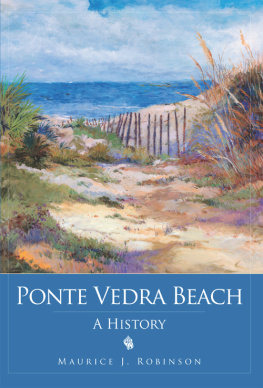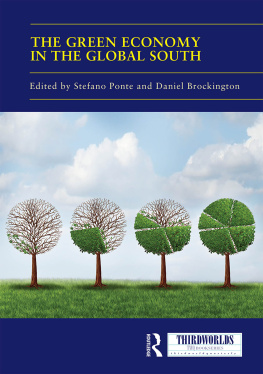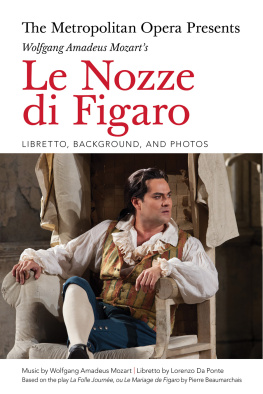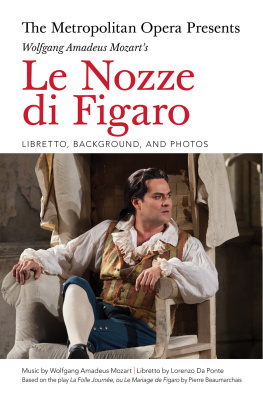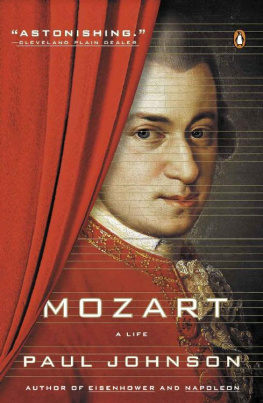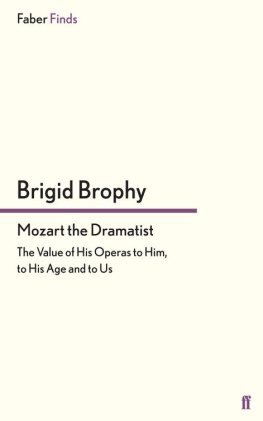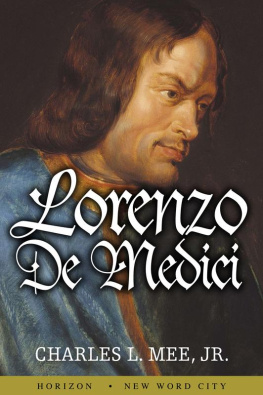OTHER BOOKS BY THE SAME AUTHOR
History Play
Lorenzo da Ponte
The Extraordinary Adventures of the Man behind Mozart
Rodney Bolt
BLOOMSBURY
First published in Great Britain 2006
Copyright 2006 by Rodney Bolt
This electronic edition published 2010 by Bloomsbury Publishing Plc
The right of Rodney Bolt to be identified as the author of this work has been asserted by him in accordance with the Copyright, Designs and Patents Act 1988
All rights reserved. You may not copy, distribute, transmit, reproduce or otherwise make available this publication (or any part of it) in any form, or by any means (including without limitation electronic, digital, optical, mechanical, photocopying, printing, recording or otherwise), without the prior written permission of the publisher. Any person who does any unauthorised act in relation to this publication may be liable to criminal prosecution and civil claims for damages.
Bloomsbury Publishing Plc, 36 Soho Square, London W1D 3QY
A CIP catalogue record for this book is available from the British Library
ISBN 978 1 4088 2074 2
www.bloomsbury.com/rodneybolt
Visit www.bloomsbury.com to find out more about our authors and their books.
You will find extracts, authors interviews, author events and you can sign up for newsletters to be the first to hear about our latest releases and special offers.
For those who
shine in small corners
Chi crede a' sogni matto; e chi non crede, che cos'?
He who believes in his dreams is mad;
and he who does not believe in them what is he?
Lorenzo Da Ponte
Contents
I am most grateful to the Authors' Foundation for a grant that contributed considerably towards the travel costs involved in researching this book.
My thanks, too, to my agent David Miller and editor Bill Swainson for their enthusiasm and support, and to Emily Sweet for her careful eye. Especial thanks go to Chris Chambers, who introduced me to Da Ponte, and to Philip Balma, whose work on the trickier translations, particularly with Da Ponte's letters and verse, has been invaluable. To those who helped untie me often at a moment's notice when I was bound up in further linguistic knots, a huge grazie, as well as a vielen Dank: to Lorenza Bacino, Sandra Ponzanesi, Liliana Pestman, Nele Ysebaert and Shaun Whiteside. Anya Schiffrin and Joe Stiglitz offered warm and unstinting hospitality in New York, which was hugely appreciated, as was Bob Bomersbach's spontaneous and energetic help with research. Lorna Marshall's advice was, as ever, a gem.
I owe a debt to earlier biographers Joseph Louis Russo, April FitzLyon, Sheila Hodges, and Aleramo Lanapoppi, and in particular to Andrew Steptoe, whose book The MozartDa Ponte Operas (Oxford University Press, 1988) did much to guide my thinking on the social context of opera in Vienna. References to Da Ponte's letters were sourced from Lorenzo Da Ponte, Lettere, edited by Giampaolo Zagonel (Dario De Bastiani, 1955), and I am most grateful for his permission to do this. I would also like to thank the Rare Book and Manuscript Library, Butler Library, Columbia University and Luciano Rebay for permission to publish his translation of Da Ponte's 'Sad Farewell' to his books. Quotations from David Coward's translation of Beaumarchais in The Figaro Trilogy (2003), and from Gozzi's Useless Memoirs (edited by P. Home, 1962), are used by permission of Oxford University Press. Translations of Mozart's letters are from Mozart's Letters, Mozart's Life: Selected Letters, edited by Robert Spaethling, translated by Robert Spaethling, copyright 2000 by Robert Spaethling and used by permission of W.W. Norton & Company Inc. Extracts from the shareholders' agreement of the New York Italian Opera Association (BV Italian Opera) are quoted courtesy of the New-York Historical Society.
Staff at the British Library and in the libraries of Cambridge University and Columbia University, the New-York Historical Society and the Northumberland County Historical Society were invariably helpful, interested and prepared to cope with the odd difficult request. Sandra Stelts and her associates in the Rare Books and Manuscripts Library at Pennsylvania State University, especially, went out of their way to assist me. I am grateful, too, to Ines Griesser and the Vienna Tourist Board for their assistance, and to Reinhard Eisendle of the Da Ponte Institute.
Truly heartfelt thanks go, once again, to Hans Nicolai, Gerard van Vuuren, Andrew May and Anna Arthur. Without their tolerance of my foibles, stalwart support, and practical help, such tasks as this would simply never be completed.
Letter to Don Pietro Bortoluzzi. A.D.V.V., Seminario, b.2, fascicolo X, n. 119, Archivio Diocesano di Vittorio Veneto.
Giacomo Casanova in Dux 1796. Oil. Portrait by Francesco Casanova, his brother. Copy from the original by H. Schuddebeurs. Museum Duchcov. Photo: Marco Leeflang.
Lorenzo Da Ponte in his youth. Reproduced by kind permission of Giampaolo Zagonel.
Portrait of Wolfgang Mozart by Johann Nepomunk. Internationale Stiftung Mozarteum (ISM).
Portrait of Nancy Storace by von Bettelini. Austrian National Library, picture archives, Vienna (Anna Selina Storace, v. Bettelini 1788, NB 512.468-B).
Emperor Joseph II at the clavier. Kunsthistorisches Museum, Wien.
Portrait of Michael Kelly by John Neagle. National Portrait Gallery, London.
The Michaelerplatz, Vienna. Copyright Wienmuseum.
Interior of the Burgtheater. From H. C. Robbins Landon's Mozart: The Golden Years.
Portrait of Wolfgang Mozart by Johann Georg Edlinger. bpk/Gemldegalerie, SMB/Photo: J. P. Anders.
Portrait of Antonio Salieri by Heinrich Eduard von Wintter. Austrian National Library, picture archives, Vienna (Antonio Salieri, Stich v., Winter 1815, 106.803-C).
Costumes from Salieri's Axur, re d'Ormus. Gabinet Rycin Biblioteki Uniwersyteckiej w Warszawie.
1791 cartoon satirizing the London opera battles. V&A images/Victoria and Albert Museum, London.
Anna Celestina Ernestina 'Nancy' Grahl. Collection of The New-York Historical Society (negative #78494d).
Ticket for the premiere of Le nozze di Figaro. Austrian National Library, picture archives, Vienna (Theaterzettel: Le Nozze di Figaro 1786, NB 606.783-C).
Five Points, New York. Collection of The New-York Historical Society (negative #44668).
The Italian Opera House, New York. From Henry Krehbiel's Chapters of Opera (New York, 1908).
Interior of the Park Theatre, New York. Collection of The New-York Historical Society (accession #1875.3).
Professor Da Ponte at Columbia College, New York. Unidentified artist: Portrait of Lorenzo Da Ponte, Columbia University in the City of New York.
Portrait of Lorenzo Da Ponte by a Venetian painter of the nineteenth century, from a miniature by Nathaniel Rogers (1788-1844), oil on canvas, 630 550mm. Museo del Cenedese, Vittorio Veneto, Treviso, Italy (photo from Museo del Cenedese, Treviso, Italy).
View of New York from Brooklyn Heights. Collection of The New-York Historical Society (negative #74719).
IN THE 1958 Lerner-Loewe musical Gigi, the characters played by Maurice Chevalier and Hermione Gingold recall a love affair of long ago. They met at nine, he recollects; at eight, she dryly corrects him. He was on time, the old man reminisces; no, late, says she. But, oh yes, he remembers it well they dined with friends. Alone. As he recalls, a tenor sang. It was a baritone. But, of course, he remembers it all. Families recounting old anecdotes stumble down a similar 'It was on a Thursday', 'No, a Wednesday' path. Nor are the writers of memoirs exempt from what may be called the Gigi effect. Biographers are frequently faced with sincerely held, yet fundamentally conflicting, versions of the same event from different sources. Then, there are the lies outright as writers of autobiographies exercise their prerogative to display themselves in the brightest possible plumage.
Next page


